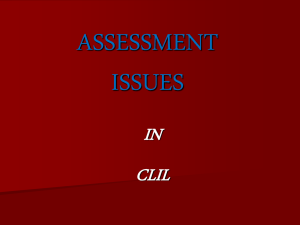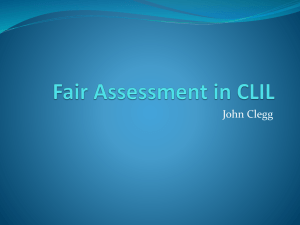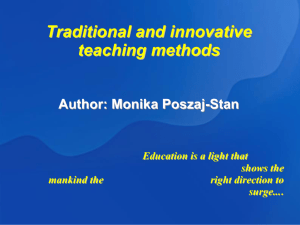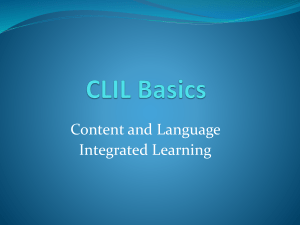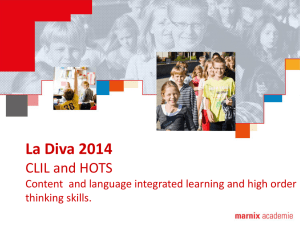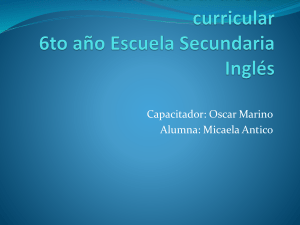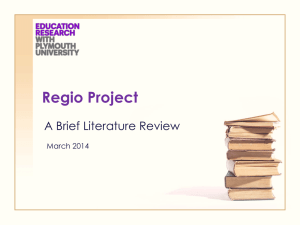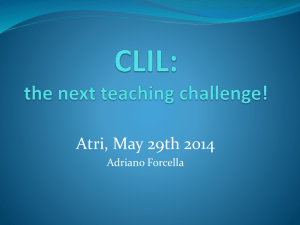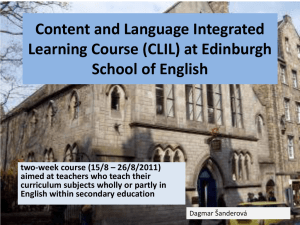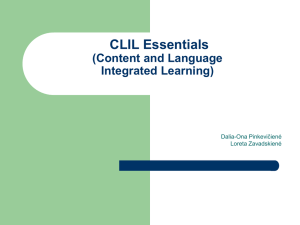Using Essential Science
advertisement
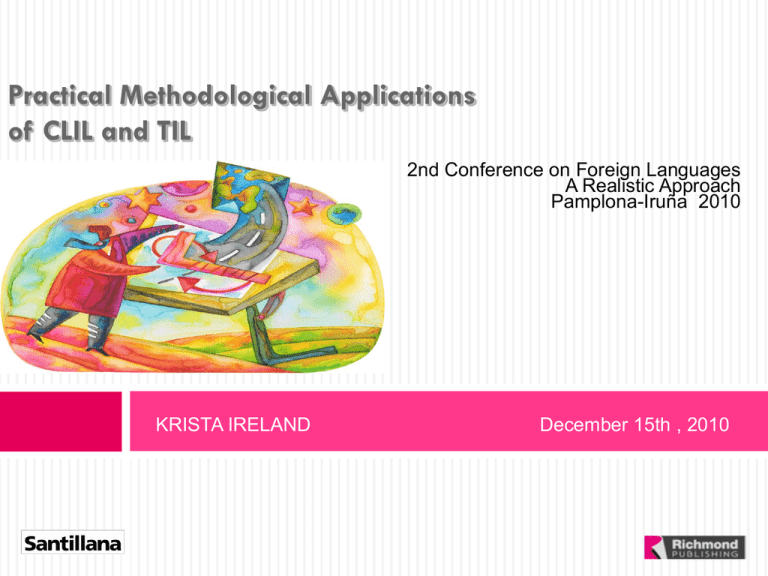
Practical Methodological Applications of CLIL and TIL 2nd Conference on Foreign Languages A Realistic Approach Pamplona-Iruña 2010 KRISTA IRELAND December 15th , 2010 Congratulations for forming part of a top team of pioneering professionals ! Thank you for being here today! Multilingualism in Europe & Spain Look how far we have come! Pre-WWII Education: Minimum literacy. Elitist higher education. Little language learning. The Grammar-translation. Democratic transition. Post WWII: Top Priority ! Ensure peace + rebuild Europe •Education • Languages • Mobility Creating Plurilingual schools is a challenge. 1.4 What have we learned? Plurilingual settings require a great deal of implication from staff, parents, students, school council, etc. Requires planning and organization. Requires a high standard of professional training. Motivates the rest of the school to participate in foreign language activities and try new teaching practices. Facilitates the training of students to integrate as citizens while fomenting tolerance, respect for other cultures Reflections from Rosa María de Castro Director IES San Juan Bautista British Council MEC Madrid Where to start? Today’s session… 1. 2. 3. 4. 5. 6. Understanding CLIL and TIL Planning the use of spaces. Sharing in the staffroom. Meeting and coordination tips. Choosing the right materials. Planning for personalized lessons that caters to the context and diversity. This looks good ! 1. How does CLIL work? In a CLIL lesson, the subject defines the language that is used. The target language is used both to learn about the subject and to communicate. Students acquire language through exposure. Support can be offered through focused instruction in a language class in some cases. The centre, as well as the Language and Content teachers coordinate to plan the building of knowledge. This provides a sucessful learning foundation. 1. What are some CLIL models? MAINLY LINGUISTIC LINGUISTIC CLIL CLIL Content topics MAINLY CONTENT-BASED CLIL CONTENT-BASED CLIL Minimum Curricular requirements LANGUAGE CONTENT 1 CLIL Methodology and background 1. Typical CLIL and TIL subjects? Arts and crafts Science, geography and history Music Physical Education 1.Understanding CLIL and TIL Decretos Forales 24 /2007 25/2007 Include the linguistic realities of both of the following methodologies : CLIL: Organized instruction of Content Teaching in another language = learning by doing. TIL: Integrating Language Learning and Content learning via Topics, subject areas, project work, genres, etc. 1. What does TIL look like? Coordinated topic units: Science: The forest English: The Giving Tree Art: Landscapes and symmetry Math: Lines and angles in nature Physical Education: Hiking and climbing as sports 1. How de we plan for CLIL and TIL? This requires quite a bit of ORGANIZATION AND PLANNING! 2. Planning the use of spaces Map for out the use your school spaces: project work and art displays. for outdoor projects like a fish pond & gardening. to have specific rooms for subjects when a lot of hands-on materials are needed: science, art , computer room & music. by considering Ietting children change classes. by minimizing the amount of TEACHER changes from pavilion to pavilion. use a suitcase with wheels to transport materials. use a portable computer, speakers & white board. 2. Planning the use of spaces Manage classrooms to create environments. Why do we only apply Corners theory to classrooms at Infant level? Computer corner Super star corner: extra worksheets box: extension and revision points Rest & reading corner 3. Sharing in the staffroom Plan your teacher’s room to share materials. 3-ring binders for lesson plans/flashcards. Hangers or clips & a rack for posters. Sign out sheets for materials. Have all computers connected to Intranet. Timing sheet with unit coordination & yearly planning. Plan for the unpredictable too! 4. Meeting & coordination tips Plan weekly and monthly coordination meetings. Agree that everyone will help. Set tasks. Designate a chairperson by term /month to share responsibilities and keep meetings moving. Previously plan & distribute an agenda to stay on track in meetings & class. Contact & share materials with each other by email such as interesting web-sites, blogs, chats, File-dropper, etc. Have common files in a digital medium such as Intranet and / or print files to keep materials. Consider a peer-observation calendar and inhouse teacher training sessions. Use your Richmond-Santillana materials be a core foundation. Let’s plan to do this hands-on experiment for unit 3. 4. Choosing the right materials What is the role of a text book? To guide & facilitate coordination and materials selection. What is the role of the teacher? To coordinate for their centre and adequate materials for students. CLIL and TIL FOR PRIMARY ICT resource for Essential Science 3rd cycle: has 1 Web Quest per term Includes ICT lesson plans & photocopiable maps. Richmond World Facts Readers 1-6 Your classroom library with teaching suggestions, Worksheets and project ideas! CD audio with every book! This collection helps to: •reinforce science contents. •foment literacy. •integrates key competences. 6. Planning personalized lessons Planning to get the most out of your classroom materials How to turn an idea into reality…. First comes thought; then organization of that thought, into ideas and plans; then transformation of those plans into reality. 1. Introduction: CLIL in Spain today The beginning, as you will observe, is in your imagination. -Napoleon Hill Planning units: basic lesson structures PPP lesson = Presentation, Practice & Production Project or Skills lesson = Pre- skills / project task, while doing skill / project task and post skill /project task Session 1: PPP lesson Session 2: Project or skills lessons ICT= Hands-on interaction: blogs, web pages, reference, webquests, etc. http://projects.edtech.sandi.net/grant/insects/ TTT = Test, Teach, test Indirect or direct Diagnostic, formative, and summative Ts-Ss, Self-evaluation, Peer Evaluation, Ss-Ts Session 3: ICT lesson Session 4: Science library & skills consolidation Session 5: Student Assessment Your weekly lesson-unit planning Session 1: PPP lesson •The Essential Science Teacher's Book offers step by step suggestions. •Use the Student’s Book & Activity Book. •Plan to use the E-book CD’s , digital flashcards or posters for digital whiteboard to present and correct. Session 2: Project lessons provide hands-on experimentation •First show a demonstration of the projects then give step by step instructions. •Let student’s work in pairs or small groups in order to de the task. •Finally let students share results and do wither self or peer evaluation. Session 3: ICT lesson Use a digital whiteboard to present and walk through the chosen task. Let students do the task. Remember , ICT is to build skills looking for information and communicating! Ask students to present or share information via posters, web pages, blogs, classroom presentations, etc. Session 4: Science library & skills consolidation Access science, geography and history library books from the RWF collection. Use ready made lesson plans for the group or support individual choices by using a Super Star Box. Integrate worksheets to stimulate reading for a purpose and assessment. Session 5: Student Assessment Plan for student presentation of research & findings especially in 3rd cycle. Do normal formal testing from ICT CD 1 or allow for open book exams. Don’t forget games can be used as informal testing & review. Planning Planning your sessions is easy. Attend Ss needs by “lifting” from the page. Make sure it can be easily followed by others. Use the following model to outline steps for sessions and materials. T’s-evaluation tool: once you give the lesson, write notes in red pen: what went well, what could you change? Share your lesson plans on-line and via print copies in 3-ring binders. Timing & Interaction Activity & materials Basic Comp. Aims Assesment Ts-Ss 10 min. Warmer: Science Flashcard & Wordcard memory game recognizing body parts. (blue tack and B/B) BC: 1, 7, 8 Activate vocabulary knowledge Diagnostic testing SS-pairs 10 min. Pre-listening Activity: Remind Ss of the1st cycle song “Head, shoulders, knees and toes”. Ask Ss to try and remember the lyrics (singing softly to themselves) and write the order of the body words in their notebooks. BC: 1, 3, 6, 7, 8 Activate and consolidate vocabulary knowledge Diagnostic testing & setting stage for selfevaluation Audio x1: Pairs 5min. While listening activity: BC: 1, 3, 5, 6, 7 Activate and consolidate vocabulary knowledge Formative testing with self-assessment Audio x2: Whole group 5 min. Audio x 1: Listen to the song and check answers. Audio x 2: Dance and sing the song once. 15 min. Ts-ss After listening activity: Use Level 3 Unit 3 ICT digital E-book & Audio Presentation Flashcards to present and compare body parts and skeleton. BC: 1, 3, 6 Introduce semantic & phonetic aspects of parts of the skeleton Formative: drill pronun. 5 min Ts-ss Homework: Print the ICT digital Poster on the skeleton with and without answers to fill in for next session. BC: 1, 3, 7, 8 Learner autonomy & study / memory skills Formative testing /selfassessment CP Miguel Porcel Palma : An excellent PPP lesson http://www.youtube.com/watch?v=OWF1djKCY3M& feature=related Look at the picture and predict what this lesson might be about. While watching the lesson, map different stages of the teacher’s original lesson plan. Fill in the ACTVITY STAGES. Steps to coordinate Practice adapting / planning your own sessions. First, get into pairs and look at your resources. Brainstorm contents, language and activites while keeping context in mind. Transfer the info to your lesson/unit worksheet. Thank you for your participation today! 'Do not go where the path may lead; go instead where there is no path and leave a trail'. Ralph Waldo Emerson PLEASE FEEL FREE TO REACH ME AT… KRISTA IRELAND IRELANDK@SANTILLANA.ES CLIL Bibliography Bialystok, E. 2004. «The impact of bilingualism on language and literacy development». In Bhatia, T.; Ritchie W. (eds.). The Handbook of Bilingualism. Oxford: Blackwell, 577-601. Dalton-Puffer, C. 2007a. Discourse in Content and Language Integrated Learning (CLIL). Amsterdam: John Benjamins Publishing. Dalton-Puffer, C. 2007b. Research on CLIL-where do we stand? Paper presented at the Universidad Autónoma de Madrid, March 2007. Dafouz, E. Núñez, B. y Sancho, C. 2007. Analysing Stance in a CLIL university context: non-native speaker use of personal pronouns and modal verbs, in International Journal of Bilingual Education and Bilingualism. Vol. 10 (5). Special Issue on CLIL. Clevendon, England: Multi-lingual Matters. 647-662 Escobar, C. y Pérez Vidal, C. 2004. Teacher Education for the implementation of Content and language integrated learning approach (CLIL) in the School System en Wilkinson, R. (ed) Integrating Content and Language. Meeting the challenge of a Multilingual Higher Education. Maastrich: Maastrich University Press. Pp. 402-415. Genesee, F. 1987. Learning through two languages: Studies of immersion and bilingual education. Cambridge MA: Newbury House. Krashen, S. 1985. The Input Hypothesis: Issues and Implications. Longman, New York. Llinares, A. and Whittaker, R.(in press). Teaching and learning history in secondary CLIL classrooms:From speaking to writing. En Dafouz, E. y Guerrini, M. (eds) CLIL across Educational Levels. Experiences from primary, secondary and tertiary contexts. Londres: Richmond Santillana. CLIL Bibliography (cont.) Lyster, R. 2007. Learning and teaching languages through content. Amsterdam: John Benjamins. Marsh, D. 2001. Using Languages to learn and learning to use languages. Marsh, D. 2002. «The relevance and potential of content and language integrated learning (CLIL) for achieving MT+2 in Europe». Euro-Pérez Vidal, C. y Campanale Grilloni, N. (eds.) 2005. Content and Language Integrated Learning in Europe. Teaching materials for use in the secondary school classroom. Barcelona: Gráficas Revenaque. Pérez Vidal, C. 2007.‘The European Framework of Reference: The Portfolio.’ En Usó, J. and RuizMadrid, N., eds. Pedagogical reflections on learning languages in instructed settings. Cambridge: Cambridge Scholar Press. Pérez Vidal, C. 2008. ‘El Enfoque Integrado de Contenidos y Lengua en Europa.’ Aula de Innovación Educativa, 168, pp.7-17. Schmitt, N. (ed.) (2002) An Introduction to Applied Linguistics. London: Arnold. Van de Craen, P.; Lochtman K.; Ceuleers, E.; Mondt, K.; Allain, L. 2007. «An interdisciplinary approach to CLIL learning in primary schools in Brussels». In Dalton-Puffer, C.; Smit, U. (eds.). Empirical Perspectives on CLIL Classroom Discourse. Frankfurt am Main: Peter Lang, 253-274. Vollmer et al.2006. Subject-specific competence in and language use of CLIL learners: the case of Geography in grade 10 of secondary schools in Germany. Paper presented at the ESSE8 Conference in London, 29 August 2006. Wildhage, M. y Otten, E. 2003. «Content and Language Integrated Learning», in Praxis des bilingualen Unterrichts, eds M Wildhage and E Otten, Cornelson, Berlin, pp. 12-45.
